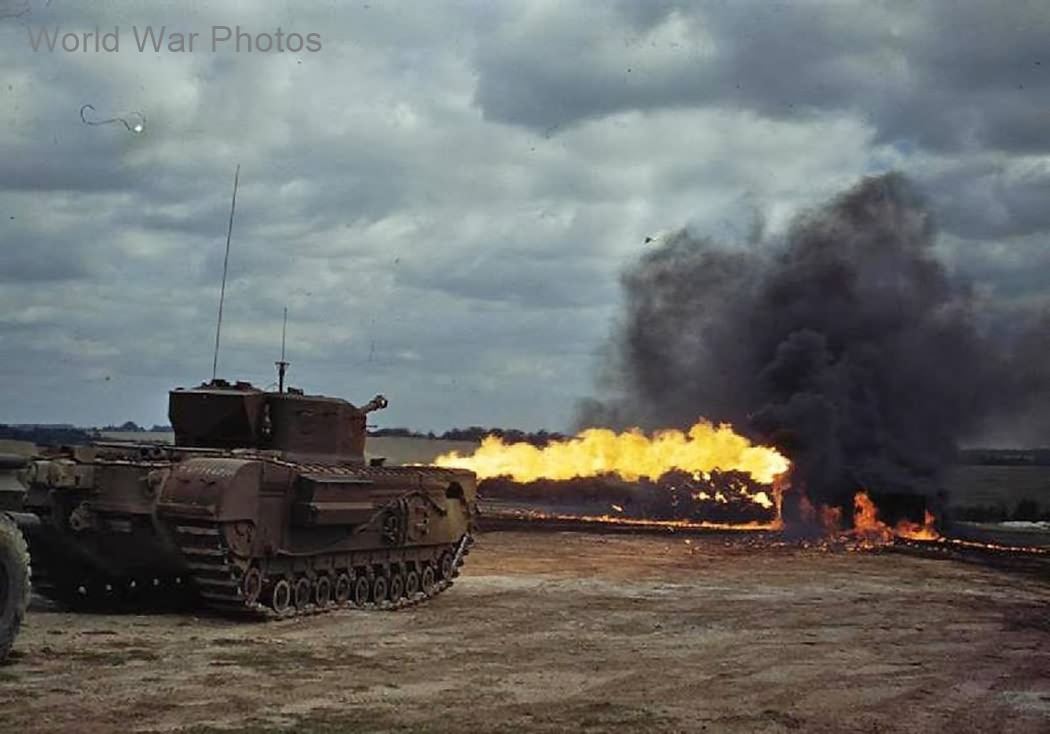The Churchill Crocodile Flamethrower Tank was a specialized British armored vehicle developed during World War II to enhance the capabilities of Allied forces in assaulting fortified positions. It was one of the most fearsome and effective flamethrower tanks used during the conflict, particularly noted for its role in the Normandy invasion and subsequent European campaigns.
Development and Design
Origins and Early Flamethrower Development:
- The British Petroleum Warfare Department had been experimenting with armored flamethrower vehicles since early in the war. The Churchill tank, known for its heavy armor and reliability, was a logical platform for such a weapon.
- An early attempt to deploy a flamethrower tank, the Churchill Oke, was used during the Dieppe Raid in 1942, but it proved ineffective due to limited range and fuel capacity.
The Crocodile Design:
- Learning from the shortcomings of the Oke, British engineers began developing a more advanced flamethrower tank in late 1942. The result was the Churchill Crocodile, which featured a specialized armored trailer to carry 400 gallons of fuel and pressurized gas.
- The Crocodile’s flamethrower was capable of projecting a stream of flame up to 150 yards, making it highly effective against enemy fortifications, bunkers, and infantry in entrenched positions. The flame gun was mounted on the right front corner of the tank’s hull.
Refinement and Production:
- The Crocodile underwent various refinements throughout early 1943, with production authorization granted in August 1943. By March 1944, prototypes and production models were being demonstrated to Allied commanders and observers, including the US Army.
- Despite the interest from the US Army in adopting the Crocodile flamethrower, particularly by mounting it on the Sherman tank, production constraints and the British Army’s own needs meant that no Sherman Crocodiles were delivered to US forces in time for D-Day.
Deployment in Operation Neptune (D-Day)
Production and Deployment Challenges:
- The British Army had a pressing requirement for 176 Crocodiles in preparation for the Normandy invasion, but production delays meant that only 70 were delivered by June 1, 1944. This was far fewer than planned, impacting their deployment during the initial assault waves.
- On D-Day, June 6, 1944, just six Churchill Crocodiles were deployed, assigned to two troops of C Squadron, 141st Regiment, Royal Armoured Corps (RAC), which landed on Gold Beach. Despite their small numbers, the Crocodiles were instrumental in clearing bunkers and other fortified positions on the beach.
Combat Effectiveness:
- The Crocodile’s ability to incinerate enemy positions from a relatively safe distance made it a psychologically devastating weapon. German soldiers often surrendered when they saw a Crocodile approaching, fearing the horrific effects of its flamethrower.
- In subsequent operations following D-Day, the Churchill Crocodile continued to be used effectively in clearing fortified positions across Northwest Europe, proving its worth in urban combat and siege warfare, where traditional tank guns were less effective.
The Churchill Crocodile remains one of the most iconic flamethrower tanks of World War II. Its development and deployment underscored the importance of specialized armored vehicles in modern warfare, particularly in overcoming entrenched enemy defenses. Despite the limited numbers available on D-Day, the Crocodile’s impact was significant, contributing to the success of the Allied landings and the subsequent push into occupied Europe.
